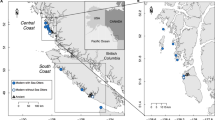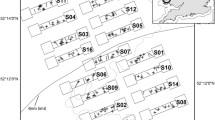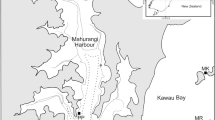Abstract
Mussel (Mytilus californianus) populations were studied throughout California to determine changes over the past few decades, and, in particular, to determine if declines reported for southern California have occurred outside of the region. We compared mussel cover, biomass, and bed thickness reported in historic studies in the mid-1970s to 1980s with measurements made in 2002. Mussel cover and biomass in southern California declined markedly over the past few decades with a mean cover loss of 31.2% (40.2% loss) and biomass loss of 25.1 kg m−2 (51.3% loss). Changes in mussel bed thickness were not as strong as cover and biomass, but also appeared to decline over time. Declines were limited to the southern California region, since mussel cover, biomass, and bed thickness remained unchanged or increased at sites in central and northern California. Causes for mussel declines in southern California are unknown, but may include human visitation, increased sea surface temperatures, and pollution.


Similar content being viewed by others
References
Ackermann JM (1971) The demography of the marine mussel, Mytilus californianus. PhD Thesis, Department of Zoology, University of California, Berkeley
Alexander GV, Young DR (1976) Trace metals in southern Californian mussels. Mar Pollut Bull 7:7–9
Altstatt JM, Ambrose RF, Engle JM, Haaker PL, Lafferty KD, Raimondi PT (1996) Recent declines of black abalone Haliotis cracherodii on the mainland coast of central California. Mar Ecol Prog Ser 142:185–192
Ambrose RF, Engle JM, Raimondi PT, Wilson M, Altstatt JA (1995) Rocky intertidal and subtidal resources: Santa Barbara County mainland. Final report to the Minerals Management Service. OCS Study MMS 95–0067
Ambrose RF, Smith JR (2005) Restoring rocky intertidal habitats in Santa Monica Bay. Technical Report for the Santa Monica Bay Restoration Commission, California
Brosnan DM, Crumrine LL (1994) Effects of human trampling on marine rocky shore communities. J Exp Mar Biol Ecol 177:79–97
Coe WR, Fox DL (1942) Biology of the California sea mussel (Mytilus californianus). I. Influence of temperature, food supply, sex and age in rate of growth. J Exp Zool 90:1–30
Coe WR, Fox DL (1944) Biology of the California sea-mussel (Mytilus californianus). III. Environmental conditions and rate of growth. Biol Bull 87:59–72
Eganhouse RP, Young DR (1976) Mercury in tissues of mussel off southern California. Mar Pollut Bull 7:145–147
Eganhouse RP, Young DR (1978) In situ uptake of mercury by the intertidal mussel, Mytilus californianus. Mar Pollut Bull 9:214–217
Engle JM, Davis GE (2000a) Baseline surveys of rocky intertidal ecological resources at Point Loma, San Diego. U.S. Department of Interior, Geological Survey, Sacramento, California
Engle JM, Davis GE (2000b) Ecological condition and public use of the Cabrillo National Monument intertidal zone, 1990–1995. U.S. Department of Interior, Geological Survey, Sacramento, California
Gordon M, Knauer GA, Martin JH (1980) Mytilus californianus as a bioindicator of trace metal pollution: Variability and statistical considerations. Mar Pollut Bull 11:195–198
Holbrook SJ, Schmitt RJ, Stephens JS (1997) Changes in an assemblage of temperate reef fishes associated with a climate shift. Ecol Appl 7:1299–1310
Hyrenbach KD, Viet RR (2003) Ocean warming and seabird communities of the southern California current system (1987–98): response at multiple temporal scales. Deep Sea Res II 50:2537–2565
Kanter RG (1974) Susceptibility to crude oil with respect to size, season and geographic location in Mytilus californianus (Bivalvia). Technical report prepared for the University of Southern California Sea Grant Program
Kanter RG (1977) Structure and diversity in Mytilus californianus (Mollusca: Bivalvia) communities. PhD Thesis, Department of Biology, University of Southern California
Kanter RG (1978) Mussel communities. In: Littler MM (ed) The annual and seasonal ecology of southern California rocky intertidal, subtidal and tidepool biotas. Southern California Baseline Study. Final Report, Volume III. U.S. Department of Interior, Bureau of Land Management, Washington, D.C
Kanter RG (1980) Biogeographic patterns in mussel community distribution from the Southern California Bight. In: Power DM (ed) The California Islands: Proceedings of a Multidisciplinary Symposium. Santa Barbara Museum of Natural History, Santa Barbara, CA
Kinnetics (1986) Study of the rocky intertidal communities of central and northern California, Year I. OCS Study, MMS 86-0051, U.S. Department of Interior, Minerals Management Service, Pacific OCS Region
Lohse DP (1990) Interactions between a marine mussel and its epibionts: influences on population dynamics and community structure. PhD Thesis, Department of Biology, University of California, Santa Barbara
Martin M (1985) State mussel watch: toxics surveillance in California. Mar Pollut Bull 16(4):140–146
McGowan JA, Chelton DB, Conversi A (1996) Plankton patterns, climate, and change in the California Current. CalCOFI Rep 37:45–68
Menge BA, Daley BA, Wheeler PA, Strub PT (1997) Rocky intertidal oceanography: an association between community structure and nearshore phytoplankton concentration. Limnol Oceanogr 42:57–66
Miller AJ, Cayan DR, Barnett TP, Graham NE, Oberhuber JM (1994) The 1976–77 climate shift of the Pacific Ocean. Oceanography 7:21–26
Miller AC, Lawrenz-Miller SE (1993) Long-term trends in black abalone, Haliotis cracherodii Leach, 1814, populations along the Palos Verdes Peninsula, California. J Shellfish Res 12:195–200
Murray SN, Denis TG, Kido JS, Smith JR (1999) Human visitation and the frequency and potential effects of collecting on rocky intertidal populations in southern California marine reserves. CalCOFI Rep 40:100–106
Murray SN, Goodson J, Gerrard A, Luas T (2001) Long-term changes in rocky intertidal seaweed populations in urban southern California. J Phycol 37(3):37–38
Oedekoven CS, Ainley DG, Spear LB (2001) Variable responses of seabirds to change in marine climate: California current, 1985–1994. Mar Ecol Prog Ser 212:265–281
Paine RT (1974) Intertidal community structure: experimental studies on the relationship between a dominant competitor and its principal predator. Oecologia 15:93–120
Paine RT (1984) Ecological determinism in the competition for space. Ecology 65:1339–1348
Paine RT, Levin SA (1981) Intertidal landscapes: disturbance and the dynamics of pattern. Ecol Monogr 51:145–178
Raimondi PT, Ambrose RF, Engle JM, Murray SN, Wilson M (1999) Monitoring of rocky intertidal resources along the central and southern California mainland. 3-Year Report for San Luis Obispo, Santa Barbara, and Orange Counties (Fall 1995-Spring 1998). OCS Study, MMS 99-0032, U.S. Department of Interior, Minerals Management Service, Pacific OCS Region
Richards DV, Davis GE (1988) Early warnings of modern population collapse in black abalone Haliotis cracherodii, Leach 1814 at the California Channel Islands. J Shellfish Res 12:189–194
Richards DV, Lerma D (2000) Rocky intertidal monitoring Channel Islands Nation Park 1998 Annual Report. Technical Report for National Park Services, Channel Islands National Park
Ricketts EF, Calvin J, Hedgpeth JW Revised by Phillips DW (1985) Between Pacific Tides, 5th ed Stanford University Press, Stanford, California
Robles C (1996) Managing recovery rates of mussel beds in the Southern California Bight. Prepared for The Damage Assessment Office, National Oceanic and Atmospheric Administration, Long Beach
Roemmich D, McGowan J (1995) Climatic warming and the decline of zooplankton in the California Current. Science 267:1324–1326
Schiel DR, Steinbeck JR, Foster MS (2004) Ten years of induced ocean warming causes comprehensive changes in marine benthic communities. Ecology 85:1833–1839
Schiff KC, Allen MJ, Zeng EY, Bay SM (2000) Southern California. Mar Pollut Bull 41:76–93
Segovia-Zavala JA, Delgadillo-Hinojosa F, Munoz-Barbosa A, Gutierrez-Galindo EA, Vidal-Talamantes R (2004) Cadmium and silver in Mytilus californianus transplanted to an anthropogenic influenced and coastal upwelling areas in the Mexican Northeastern Pacific. Mar Pollut Bull 48:458–464
Smith JR (2002) The effects of bait collection and trampling on Mytilus californianus communities in the southern California intertidal zone. MS Thesis, Department of Biological Sciences, California State University, Fullerton
Smith JR (2005) Factors affecting geographic patterns and long-term change of mussel abundances (Mytilus californianus Conrad) and bed-associated community composition along the California coast. PhD Thesis, Department of Ecology and Evolutionary Biology, University of California, Los Angeles
Smith JR, Murray SN (2005) The effects of bait collection and trampling on a southern California Mytilus californianus Conrad bed. Mar Bio 146:699–706
Soto M, Ireland MP, Marigomez I (2000) Changes in mussel biometry on exposure to metals: implications in estimation of metal bioavailability in “Mussel-Watch” programmes. Sci Total Environ 247:175–187
Spangenberg JV, Cherr GN (1996) Developmental effects of barium exposure in a marine bivalve (Mytilus californianus). Environ Toxicol Chem 15:1769–1774
Straughan D (1976) Effects of natural chronic exposure to petroleum hydrocarbons on size and reproduction in Mytilus californianus Conrad. In: Proceedings of and symposium: pollution and physiology of marine organisms. Academy, New York
Straughan D (1978) Analysis of mussel (Mytilus californianus) communities in areas chronically exposed to natural oil seepage. American Petroleum Institute, Washington, DC
Straughan D, Kanter R (1977) Mussel Community Study. In: Littler MM (ed) Spatial and temporal variations in the distribution and abundance of rocky intertidal and tidepool biotas in the Southern California Bight. Southern California Baseline Study. Final Report, volume III. U.S. Department of Interior, Bureau of Land Management, Washington, D.C
Suchanek TH (1992) Extreme biodiversity in the marine environment mussel bed communities of Mytilus californianus. Northwest Environ J 8:150–152
Suchanek TH (1993) Oil impacts on marine invertebrate populations and communities. Am Zool 33:510–523
Viet RR, Pyle P, McGowan JA (1996) Ocean warming and long-term change in pelagic bird abundance within the California current system. Mar Ecol Prog Ser 139:11–18
Viet RR, McGowan JA, Ainley DG, Wahl TR, Pyle P (1997) Apex marine predator declines ninety percent in association with changing ocean climate. Global Change Biol 3:23–28
Zedler JB (1976) Ecological resource inventory of the Cabrillo National Monument intertidal zone. US Department of Interior National Park Service
Acknowledgments
We are thankful to the Environmental Protection Agency, the Minerals Management Service through the Coastal Marine Institute at the University of California, Santa Barbara, and the UCLA Ecology and Evolutionary Biology Department for assistance in funding this project. We would like to thank the following people for their help in accessing sites sampled in this study: Dan Richards and the Channel Islands National Park Services; Don Canestro and the UC Rancho Marino Reserve; Peter Raimondi and Melissa Miner at UCSC; Bixby Ranch; the Hearst Castle Association; Mary Elaine Dunaway and Mineral Management Services; Virginia Gardner and the Carpinteria State Beach; Lyndal Laughrin and the UC Santa Cruz Reserve; Kathy Ann Miller and the USC Wrigley Marine Lab; Peter Connors and the Bodega Marine Labs; Linda Weinstein and the Sea Ranch Association; Cristina Sandoval and the Coal Oil Point UC Reserve. We are grateful to D. Straughan, R. Kanter, and C. Robles for input into the project. We also thank William Hamner and an anonymous reviewer for helpful comments.
Author information
Authors and Affiliations
Corresponding author
Additional information
Communicated by P.W. Sammarco, Chauvin
Rights and permissions
About this article
Cite this article
Smith, J.R., Fong, P. & Ambrose, R.F. Long-term change in mussel (Mytilus californianus Conrad) populations along the wave-exposed coast of southern California. Mar Biol 149, 537–545 (2006). https://doi.org/10.1007/s00227-005-0223-y
Received:
Accepted:
Published:
Issue Date:
DOI: https://doi.org/10.1007/s00227-005-0223-y




